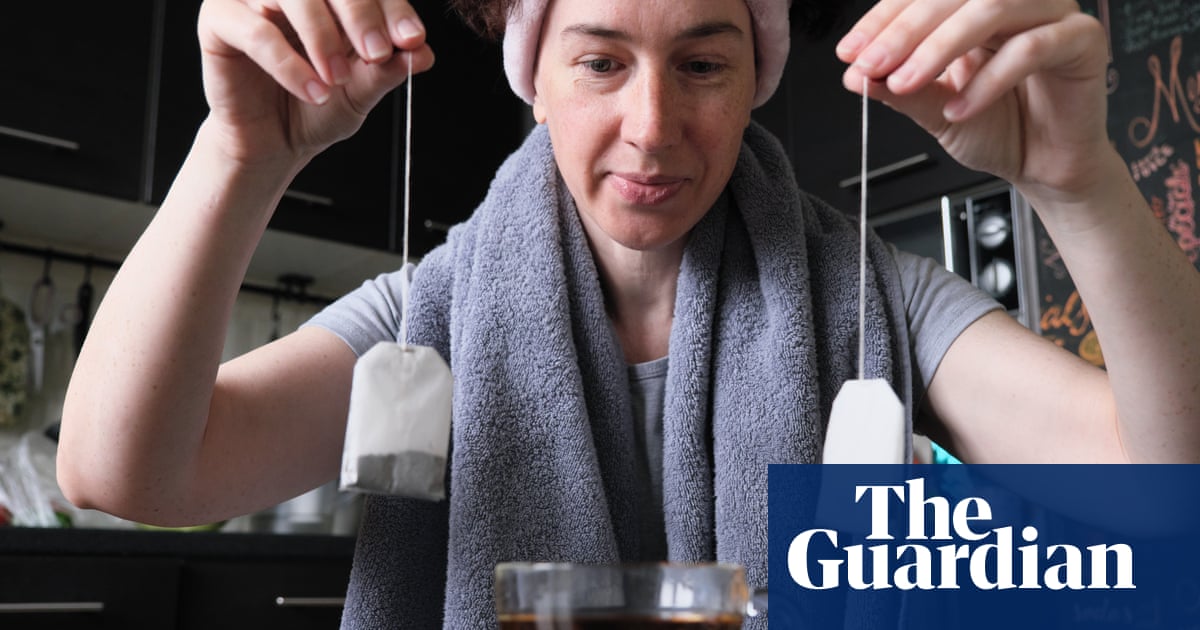
Show caption The old trick of putting cold teabags on your face to deal with puffiness actually works, says dermatologist Katherine Armour. Photograph: invizbk/Getty Images/iStockphoto Beauty How to fake a good night’s sleep: ‘In a pinch, you can use cold teabags’ Waking up with flawless skin and bouncy hair is the stuff of Hollywood fairytales. For regular humans, however, there is a cheat sheet Helen Hawkes Sun 24 Jul 2022 18.30 BST Share on Facebook
Share on Twitter
Share via Email
Maybe you’ve been kept up all night by a baby, a lover, a dinner-turned-drinks, or even gnawing worry. Maybe you’re simply one of those people who plants their face in the pillow, pulls the doona cover over – and wakes up crinkly and oxygen deprived.
Getting into bed at 3am and waking up at 7am looking perky is a young person’s game.
Face it. No one of a certain age looks their best on four hours’ sleep. Heck, some of us don’t even look our best on eight hours’ sleep.
So sleepless or otherwise, how can we maximise our good points (clear skin, for example) and minimise the not-so-good (bags, dark circles, a greyish tint)?
Do a de-puff
“Puffiness is the thing that gives you away,” says dermatologist Dr Katherine Armour, a fellow of the Australasian College of Dermatologists. “So, start with some simple measures to reduce the dilation of blood vessels around the eyes.”
She recommends applying a vasoconstrictor such as an ice pack, or a gel eye mask you put in the fridge for at least five minutes. Paul Newman famously dunked his face in a basin of iced water for around 30 seconds.
While dunking your face in ice water will help reduce puffiness, refrigerated gel eye patches should also do the trick. Photograph: CaterinaTri/Alamy
“In a pinch, you can use cold teabags,” she says. “They do actually work as the tannins act as an anti-inflammatory.”
If you feel up to it, a bit of outdoor exercise can also help stimulate lymphatic drainage and reduce overall puffiness, says Amour.
She adds that it is important for people who suffer regular puffiness to consider whether allergies may be the culprit or co-conspirator. “If hay fever is connected, taking an antihistamine before going to bed can help.
“Consider dust mite allergies too – they can be checked with a simple blood test – and make sure you change your pillow regularly.”
Keeping your head elevated during the night also means fluids don’t have a chance to gather in your face. Your ankles, maybe, but not your face.
Pat-on products (that work)
Looking after your skin by wearing a high-factor sunscreen every day of the year (90% of UV still gets through when it’s cloudy) and using a good moisturising cream also smooths and plumps up the complexion, says Armour. “And that can make it look like you had a good night’s sleep.”
A good moisturiser can be from a major pharmacy brand – “you don’t have to spend a lot”. Her favourite ingredients for soothing and calming, as well as helping produce quick improvement, include vitamin B3 (niacinamide), anti-inflammatory liquorice root extract, resveratrol and astaxanthin.
In case you’re thinking of investing in a miracle cream with the current “it” ingredient, hyaluronic acid, Armour says the molecule is way too big to penetrate the dermis when applied topically. “Some moisturisers do have compounds that penetrate a little and draw moisture into the very, very top layer, and that definitely plumps skin up a bit. But it will not penetrate the dermis where natural hyaluronic acid lives.”
Paint on some colour
Sometimes it’s the ghostly hue of the sleep-deprived that signal a restless night.
While morning exercise can give your skin a slight glow, you can also cheat.
Janelle Jerusalem, education lead at cosmetics retailer Mecca, recommends a cream-based blush for this purpose. “You can dab a little on your fingers and gently pat on your cheeks – up towards the temples, keeping the placement high to create a youthful lift.” Because it is easy to apply, you can also keep it with you when you’re out and about, she says.
Cream blush is easy to apply with your fingers for a quick flush of colour after a draining night. Photograph: Maridav/Alamy
A cream highlighter or balm is also handy, and can be applied throughout the day on the high points of the face – think upper cheekbones and upper temples.
Hello hair
It’s an accepted fact that a bad night’s sleep usually means a bad hair day.
But there is something you can do about this the night before, says Sydney hairdresser Bruce Mann. A silk pillowcase can help you “wake up with smoother, sleeker hair because it creates less static and there is no friction”.
For those with curly hair they want to revive, he suggests: “A spray bottle filled with one third conditioner and two thirds water … lightly spritz your hair when you get up, then squeeze the curl between your palms to restore bounce and eliminate frizz.”
If you have straight hair and wake up with flyaways everywhere, going through it quickly with a blow dryer and a brush will take out any moisture absorbed in the night and flatten the cuticle to be shiny and smooth, says Mann.
“If hair is just looking a little greasy and flat, sprinkle a small amount of baby powder through the roots and tousle it. This will absorb oils and gives you volume.”








